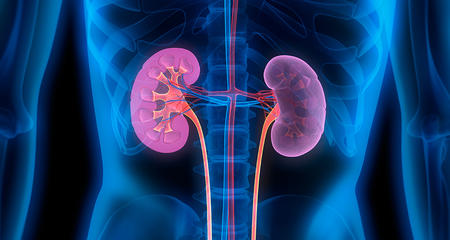Women are frequently affected by endocrine problems. Hormonal imbalances can cause health problems ranging from acne and hot flashes to more serious problems such as osteoporosis, diabetes, heart disease and depression.
Froedtert & the Medical College of Wisconsin endocrinologists diagnose and treat a wide range of hormonal imbalances that women may experience. They work with each woman's primary care physician to co-manage these disorders.
Menopause and Perimenopause
At the approach of menopause, estrogen levels fall, producing changes in the body and brain. Symptoms, which vary for each woman, include hot flashes/night sweats, sleep problems, increased anxiety or irritability, and changes in sexual interest. Treatment for symptom relief may involve behavioral modification, hormone therapy (HT) and other prescription medications. When considering HT, endocrinologists thoroughly discuss the risks and benefits for each woman. Women may be screened for low bone density (osteoporosis), which tends to develop following menopause.
Menstrual Irregularities
A woman's menstrual cycle may become irregular because of hormonal problems associated with the pituitary gland, ovaries, adrenals or thyroid gland. There are two common menstrual disorders:
- Oligomenorrhea — a reduction in the number of menstrual periods and/or amount of menstrual flow.
- Amenorrhea — absence or cessation of menstruation. In primary amenorrhea, menstruation never occurs at puberty. In secondary amenorrhea, menstruation starts but then stops.
Blood and urine tests, along with an examination and possible imaging (MRI, ultrasound) may be used to diagnose the cause and determine the best treatment.
Polycystic Ovary Syndrome (PCOS)
Polycystic ovary syndrome is a chronic disorder that involves excess production or increased sensitivity to androgens (male hormones) and abnormal ovarian function. It occurs in 5 percent to 10 percent of women of reproductive age and is the leading cause of infertility. Women with PCOS may experience irregular or absent menstrual periods. Without regular menstrual periods, women with PCOS have a higher risk for endometrial (uterine) cancer. Polycystic ovary syndrome is associated with abnormal growth of facial hair and body hair (hirsutism), scalp hair loss (alopecia) and acne.
Polycystic ovary syndrome is often associated with a clustering of metabolic risk factors including insulin resistance, pre-diabetes and diabetes, high blood pressure, cholesterol abnormalities and obesity. The diagnosis of PCOS is based on medical history, laboratory tests and sometimes an ovarian ultrasound exam. Treatment of PCOS is individualized to each woman's unique concerns and may include diet, exercise and medication to reduce symptoms, improve fertility and reduce the risk of long-term health risks. Women with PCOS receive multidisciplinary care by a team of physicians, nurses and dietitians. Women with PCOS may be referred to other specialists for care, such as:
- Bariatric surgeons
- Infertility specialists
- Dermatologists
- Psychologists or psychiatrists
Hirsutism
Hirsutism is the presence of dense, coarse hair (terminal hair) in females in a male-like pattern (above the lip and on the chin, chest, abdomen and back). Hirsutism may be associated with a number of endocrine disorders including PCOS, Cushing’s syndrome, tumors of the ovary or adrenal gland, and congenital adrenal hyperplasia. It may be familial or idiopathic, with no cause identified. Blood and urine tests can help evaluate the cause of hirsutism. Treatment is aimed at slowing new hair growth. It may include medications (hormone therapy, anti androgens and insulin sensitizers), diet and exercise, and cosmetic therapies including laser hair removal.
Premature Ovarian Insufficiency (POI)
Premature ovarian insufficiency is a stop in the normal functioning of the ovaries in a woman younger than age 40. It was formally called primary ovarian failure and is also known as hypergonadotropic hypogonadism. This results in early end of menstruation, the onset of menopausal symptoms and infertility.
POI may be due to autoimmune disease, chemotherapy, pituitary disease, complications of pregnancy or surgical removal of the ovaries. Women with POI due to autoimmune disease are at higher risk for other autoimmune diseases such as thyroid disease and adrenal insufficiency. A POI diagnosis is established by a medical history, blood tests and imaging. Treatment may include hormone therapy. Fertility specialists can discuss options such as in vitro fertilization.
Turner Syndrome (TS)
Turner syndrome is a rare condition of girls and women caused by complete or partial absence of one of the sex chromosomes. Females with Turner syndrome are of short stature, do not have menstrual periods, tend to be sexually underdeveloped and are usually infertile. TS occurs in about one of 2,000-2,500 females.
Turner syndrome is diagnosed by a karyotype, a special blood test that detects chromosomal abnormalities. Women with TS should be screened periodically for diabetes, hypothyroidism, osteoporosis, eye problems, kidney problems and heart problems. Some females with TS are first diagnosed in their teens and may receive care from a pediatric endocrinologist. At about age 18, care is transitioned to adult endocrinologists.
Osteoporosis Screening and Management
A loss of estrogen at menopause is the leading cause of osteoporosis in women. Many other disorders that affect women may also contribute to bone density loss, such as amenorrhea, POF, low body weight, eating disorders, rheumatoid arthritis and lupus. Froedtert & the Medical College of Wisconsin endocrinologists counsel women regarding screening, prevention and treatment.
A common test for osteoporosis is a bone density scan called DXA (dual energy X-ray absorptiometry). In addition, a woman may undergo a complete evaluation including blood and urine tests to check for other problems that may cause bone loss. About one-third of post-menopausal women with osteoporosis have another underlying cause for bone loss, such as vitamin D deficiency.
Treatment for osteoporosis varies with the underlying condition and may include calcium and vitamin D supplements, prescription medications that slow bone loss or stimulate new bone mass, and weight-bearing exercises.
Blogs, Patient Stories, Videos and Classes





